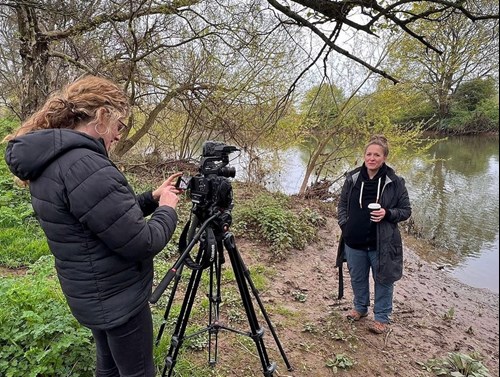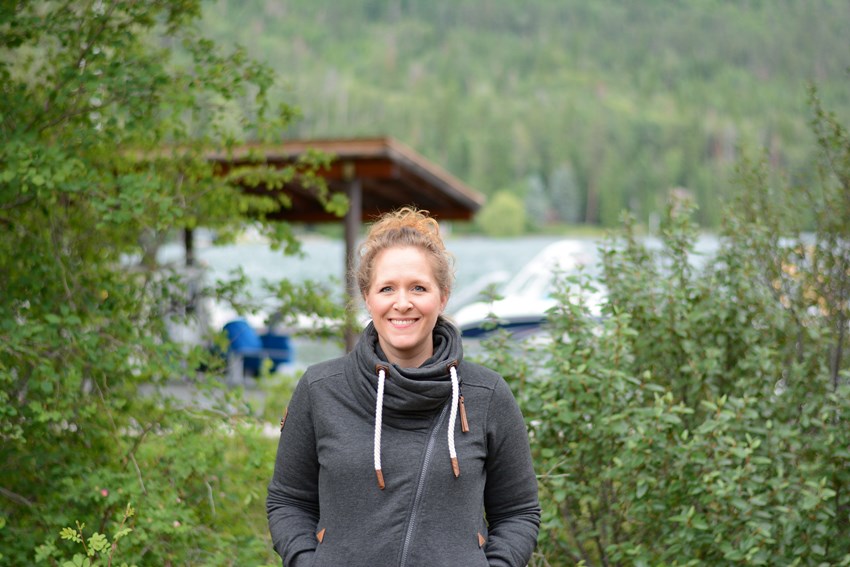Where All Things Merge: FLBS Assistant Research Professor Rachel Malison Bringing People and Pristine Waters Closer Together
By 2023 FLBS Ted Smith Environmental Storytelling Intern Najifa Farhat
On a warm, summer afternoon in northwest Montana, I look out over the Middle Fork Flathead River and see a group of individuals standing waist-deep in the gentle current. The group is hard at work amidst the gentle flow of the river, meticulously filling small plastic bottles with samples of river water.
Before them, like an instructor in front of a classroom, Flathead Lake Biological Station (FLBS) assistant research professor Dr. Rachel Malison carefully details the standard operating procedures of scientifically sound sample collection in the field.
"While collecting samples, someone in the lab wouldn't know if you have something on your hands, if your fingers are touching the lids, or if the equipment is contaminated,” Malison says. “Attention to detail is crucial to avoid any extraneous factors that could skew the results.”
This training endeavor in the Middle Fork Flathead River is conducted under the aegis of the Monitoring Montana Waters (MMW) program, the Bio Station’s philanthropically-funded, community support initiative for monitoring water quality. MMW establishes official partnerships with volunteer-led watershed groups by extending scientific, technical, and financial support to help the citizen groups create and execute freshwater monitoring plans to watch for and identify potential issues in their local water systems.
Taking part in this particular training are members of the Flathead River Alliance, a nonprofit organization dedicated to the preservation of the three forks of the Flathead River in northwest Montana. Attendees are practicing how to collect samples to measure nutrients, such as total nitrogen and total phosphorus levels.
Malison’s instructions carry across the serene sounds of the river as the training continues. This is why you use a permanent marker to label your samples, this is how to properly label your samples with date and time. One of the participants asks about the term “field blank”.
“A field blank is when we follow the same methods but fill a sample bottle with deionized water instead of river water,” Malison says. “This helps us ensure there is no contamination during field collection.”
The training is highly rigorous, and for good reason. The sample collecting procedures being taught to the group must match the standards required by Montana Department of Environmental Quality (DEQ), the state agency charged with protecting Montana’s natural environment.
For Terry Richardson, a 71-year-old Kalispell resident participating in the training, the rigor isn’t an issue.
“When you’re not talking and just listening to the river, it speaks to you,” Richardson says. “When I’m fishing, I have no thought. It’s my Zen time. So I have plenty of reasons to care about the water here, but most importantly, I believe in giving back to my community.”
Malison founded MMW back in 2021, and currently serves as its leader. But her passion for waters began long before she was a river and stream ecologist at FLBS.
Born in northern Idaho, Malison first developed a love for the outdoors while frequently visiting her grandparents' house near the Pend Oreille River. Her research journey began as an undergraduate student taking summer classes at FLBS, followed by a master’s degree at Idaho State University investigating effects of wildfire on stream ecosystems.
Malison returned to FLBS from 2009-2013 to complete a PhD focused on large river floodplains in Alaska's remote Yukon Delta National Wildlife Refuge, where she investigated the influence of beavers on juvenile salmon populations.
“You're on a jet boat with a river full of log jams and then settling yourself in a field camp,” says Malison, reflecting on her early days as an adventure ecologist. “There's just an element of excitement, stress, and anticipation throughout everything that you're pretty much doing.”
Malison would go on to become a Marie Curie Fellow and Research Ecologist at the Norwegian Institute for Nature Research, where she continued studying the impact of Eurasian beavers on juvenile Atlantic salmon and trout in Norwegian rivers. To this day, Malison remains an expert in beaver and salmon ecology, and continues to make contributions to the field through numerous papers and presentations. Most recently, she served as the keynote presentation at an international beaver conference in the United Kingdom.

FLBS assistant research professor Rachel Malison is interviewed while attending an international beaver conference as a keynote presenter in the United Kingdom in 2022.
But Malison’s passion has always remained in the rivers and streams of Montana. She would eventually return to FLBS as a postdoctoral researcher, and is currently an assistant research professor at the Bio Station. She resides in Bigfork, Montana, with her family of four, pets, and a small hobby farm.
At FLBS, Malison relishes the freedom to explore freshwaters environs. Her fascination lies in unraveling the intricate interplay between diverse facets of nature, exploring the factors that govern freshwater systems. Essentially, she's working to uncover the hidden gears that make our rivers and streams come to life across the landscape.
“Rivers and streams – that's what I gravitate to,” Malison says. “A river is not a pipe going through the landscape; it has vegetation and an entire ecosystem interacting with it. I talk about all these different paths of connectivity and linkages between the water and the land.”
Connectivity is a theme that seems to transcend all areas of Malison’s work, and is a driving force behind the MMW program and the support it provides citizen-led groups like the Flathead River Alliance.
Made possible through philanthropic support, MMW has become increasingly popular each year of its existence. In 2023, the program supported eleven community-led watershed groups, most of which are working in Western Montana.
Through MMW, Malison and her team offer in-depth training, including teaching groups how to use equipment, collect and submit samples, upload data to the Montana DEQ database, and carefully document the entire process. While the Bio Station’s analytical lab conducts most sample analyses, specialized trace materials like metals are sent to external laboratories around the U.S
All of this guidance guarantees that the monitoring conducted by citizen watershed groups is following solid scientific methods, yielding legitimate results, and making the data acceptable for Montana DEQ and other government agencies.
“The data won’t count unless we jump through all of these hoops to make sure that the state agency will use them,” Malison says. “Our aim is to utilize scientifically sound data so we can identify any issues and prompt action from governing bodies to address concerns.”
A powerful factor of MMW is its organic support that comes from local residents, whose concern over water quality and sustainability have led them to form volunteering initiatives to safeguard their water resources.
“There is a lot of value in getting regular people involved in something like water quality monitoring because I believe that’s how you start caring for water,” says Jared Glass, a Big Sky Watershed Corps Member who works with Malison in the MMW program. “When you see someone close to you talking about going out and taking water samples, it sparks a sense of connection and concern. Rachel does a really good job of prioritizing the process by making it attainable.”
A prime example of MMW's impact is the Kootenai Watershed Alliance, a citizen-operated water quality group focused on tracing pollutant concentrations in Lake Koocanusa and the Kootenai River.
The Kootenai Watershed Alliance's monitoring program is largely dedicated to tackling the specific issue of the pollutant selenium leaching from coal mines in British Columbia. The primary objective of this program will be to deliver data that may potentially play a pivotal role in shaping management strategies and informed conservation choices within the region.
For Malison, playing the part of outreach advocate is a role she embraces. She enjoys participating in discussions concerning rivers, ecosystems, and the steps we can take to sustain them for generations.
Through active involvement in an array of outreach initiatives, including diverse activities undertaken by FLBS and MMW, she seizes opportunities to disseminate her knowledge. Utilizing MMW as her platform, Malison deftly harnesses the power of concerned citizens and grassroots networks.

Malison (front, second from right) joins members of the Bitterroot River Protection Association for a freshwater sample standard operating procedure training session.
This has all led to her most recent significant accomplishment: securing a substantial $6.6 million Environment Protection Agency (EPA) grant. The grant's purpose is to create a comprehensive network examining the presence of pesticides within the waters of Upper Columbia River Basin of Montana.
Known as the Pesticide Stewardship Partnership Program, the project will encompass a region spanning 12 counties in Western Montana where it aims to meticulously measure and document the presence of pesticides in surface waters, filling a major data gap, and implement actions on the landscape to reduce the input of pesticides into our freshwaters.
“The fact that we had MMW allowed me to write this grant,” says Malison. “Without MMW, I wouldn’t have the resources backing me up, nor would I have had the initial network of stakeholders and agencies in place that I needed to convince the EPA that I can do this.”
For decades, Malison has immersed herself in a variety of pursuits driven by her innate curiosity for exploring nature. Her endeavors have encompassed research, student mentoring, and fostering a sense of community commitment aimed at nurturing the environment. Ultimately, her focus converges on the protection of water resources.
"Everything circles back to the vital role of flowing water and its intricate connections with the environment,” says Malison. “It’s exciting to be able to offer these opportunities for Montana communities, and help strengthen the connections between our pristine waters and the people who rely on them.


